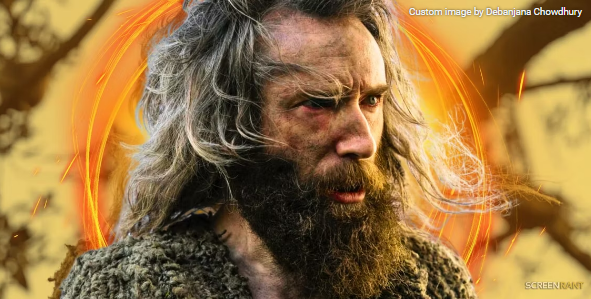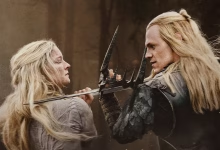The Rings Of Power’s Gandalf Twist Has Created An Impossible LOTR Problem

The Lord of the Rings: The Rings of Power may come to regret the massive Gandalf hint dropped at the end of its first season and confirmed at the end of its second. Amazon’s Tolkien TV show, set in The Lord of the Rings’ Second Age, introduced two mystery characters in its debut season: Daniel Weyman’s the Stranger and Charlie Vickers’ Halbrand. The two most popular Stranger theories speculated that the fallen Harfoot-botherer was either Sauron or Gandalf. Ultimately, Halbrand turned out to be Sauron and The Rings of Power’s ending heavily insinuated the Stranger is Gandalf.
The Stranger’s true identity was not quite as iron-clad as Halbrand’s, who unequivocally revealed himself to be The Lord of the Rings’ jewelry-making main enemy. However, the end of The Rings of Power season 2 finally confirmed what the season 1 finale had hinted: The Stranger is Gandalf. The season 2 finale cemented the tease from season 1, with the Rings of Power Gandalf referring to himself by name when acquiring his staff. However, Gandalf being in The Rings of Power is already creating problems for the Lord of the Rings prequel.
The Rings Of Power’s Gandalf Is Already Creating Problems For Future Seasons

Meeting the obscenely high bar set by Peter Jackson’s Lord of the Rings movie trilogy was arguably The Rings of Power’s biggest challenge, and the most direct comparisons season 1 faced concerned Amazon’s recasts – Morfydd Clark replacing Cate Blanchett as Galadriel and Robert Aramayo taking over from Hugo Weaving as Elrond. The elves’ original movie depictions are both beloved, which set huge expectations for The Rings of Power to meet.
Neither, however, are as beloved as Ian McKellen’s Gandalf, and that gives The Rings of Power a much bigger headache. Not only will future seasons struggle depicting a Gandalf as popular and iconic as the wizard in Peter Jackson’s Lord of the Rings movies, but the confirmation at the end of season 2 also means there are going to be significant timeline problems.
Because the Stranger’s identity was a total mystery at the beginning, he entered The Rings of Power with no expectations attached. His characterization was completely original, containing flecks of darkness and occupying a deep state of confusion over his arrival in Middle-earth.
Now a thread is directly connecting the Stranger and Gandalf, The Rings of Power season 3 and beyond need to actually give Daniel Weyman’s hairy wizard all the familiar characteristics Gandalf has. With his mind clearer by the end of season 1, audiences will expect to see the character they know and love, not a raving, childlike recluse.
This immediately heaped far more pressure on The Rings of Power season 2 – pressure that the Gandalf confirmation during the finale only increased for season 3 and beyond. Ian McKellen’s Gandalf is a performance that cannot be topped, and after the The Rings of Power season 1 finale’s “follow your nose” tease and season 2’s scene where the wizard finally gets his staff, Weyman’s Gandalf-ness will come under the microscope.
When recasting an iconic role, many movies and TV shows deliberately make the new interpretation different, hoping to avoid like-for-like comparisons between past and present characters. The Rings of Power doesn’t have that luxury, since reinventing Gandalf amounts to Tolkien sacrilege.
Thus, season 1’s Gandalf line has created a no-win scenario. Future seasons of The Rings of Power can either disappoint fans who were excited by continuing to write the Stranger with an entirely different personality to Lord of the Rings’ most famous wizard, or it can run with the Gandalf clue and endure the inevitable, unwinnable comparisons between Weyman and Ian McKellen.
Gandalf’s Presence In The Rings Of Power Creates A Canon Problem Too

The Rings of Power season 1 followed Tolkien canon about as closely as Fëanor followed the rules of Valinor after creating the Silmarils, but despite making countless deviations and condensing the timeline, The Rings of Power was usually careful to avoid rewriting Middle-earth lore wholesale. Stories such as the Southlands transforming into Mordor and Galadriel’s connection to Sauron may not have been plucked from Tolkien’s legendarium, but neither did they outright contradict it.
Including Gandalf in The Rings of Power risks breaking that rule. Tolkien stated that Gandalf did not come to Middle-earth until the Third Age and, indeed, was reluctant to be included among the wizards sent to counter Sauron. Gandalf’s hesitancy to fight in the Third Age makes the prospect of him visiting in the Second Age as “the Stranger” difficult to entertain. It represents a much more significant break from canon than most of the other alterations made by The Rings of Power.
Can Gandalf’s Original Form Solve The Rings Of Power’s Problem? Probably Not

Peter Jackson’s The Lord of the Rings movies gloss over the matter somewhat, but Gandalf is not strictly a wizard. Just like Saruman and Radagast, he is an angelic spirit – a Maia – who serves the God of Tolkien’s fantasy world. Five Maia were picked to travel to Middle-earth in the guise of wizards, which is how Gandalf ultimately becomes involved in The Lord of the Rings.
Crucially, the wizards only possess vague memories of their Maia forms, as well as a fraction of their true power. Many wondered if The Rings of Power season 2 would try to skirt around its Gandalf problem by calling the Stranger “Olórin” – Gandalf’s original Maia name.
Alas, that wouldn’t work either. Dubbing the Stranger “Olórin” would resolve some problems, such as Amazon avoiding the “Gandalf” moniker and Third Age Gandalf not remembering his involvement in The Rings of Power, but the two biggest issues would remain. Although Tolkien wrote relatively little about Olórin, the character feels identical to Gandalf in personality and spirit.
Even if the Stranger called himself by his Maia name in season 2, there is no reason Olórin would behave differently to Gandalf. That means audiences would still have expected The Rings of Power’s wizard to act more like Gandalf in season 2, and will still compare Daniel Weyman to Ian McKellen.
Using Olórin as a get-out-of-Angband-free card also wouldn’t do any good for The Rings of Power’s Gandalf canon issues. As spirits, the Maiar reserve the right to travel to and from Middle-earth at will, so it is plausible Olórin might have been present in Middle-earth during the Second Age.
When the Stranger was battling the Dweller, however, the villain openly referred to her opponent as “Istar” – i.e. a wizard. This line completely rules out the possibility of the Stranger being Olórin or some spirit version of Gandalf.
The Rings Of Power Couldn’t Pretend Season 1’s Gandalf Hint Didn’t Happen

Many pointed out that The Rings of Power could haved ignored season 1’s Gandalf tease entirely, and various figures involved with the show hinted this is the direction season 2 would take prior to the confirmation of his identity in the finale.
Writer Gennifer Hutchison played down the connection between Gandalf and the Stranger, suggesting the “follow your nose” comment may have been passed down from one character to another. Likewise, creators JD Payne and Patrick McKay have refused to acknowledge any link between the Stranger and Gandalf, even suggesting Daniel Weyman’s character could have been revealed as a villain,
“Wizards can be as evil and as dangerous, they can be rivals for Sauron, or allies of Sauron, and The Stranger’s journey will continue. So, I think that’s an open question still…”
However, rretending there was nothing in it would also have led to The Rings of Power season 1’s Gandalf tease being viewed as a cop-out. Amazon’s TV show positioned the Stranger’s identity as a key mystery throughout season 1, and the writers must have known Gandalf would be the first name on viewers’ minds.
The Rings of Power introduced a wizard, deliberately obscured his identity, dropped hints that said character could be Gandalf for the best part of eight episodes, then had that character speak one of Gandalf’s most famous lines in the finale. To suggest viewers were jumping the gun if they assume the Stranger is Gandalf seemed unfair – especially in hindsight now that season 2 confirmed it.
If The Rings of Power season 2 had backtracked and confirmed there iswas no connection whatsoever between the Stranger and Gandalf, the season 1 finale’s “follow your nose” callback would have felt cheap in hindsight – a reference designed to spark excitement and speculation in the short-term without any real intention of paying it off in the long-term.
How Fans Reacted To The Gandalf Twist

Unfortunately for Amazon, Gandalf being in The Rings of Power wasn’t a decision received well by fans in the slightest – at least not those familiar with J.R.R Tolkien’s established Middle-earth canon. It’s no secret that Gandalf wasn’t present for the downfall of Sauron. This was even confirmed in Peter Jackson’s The Lord of the Rings trilogy. Moments like Elrond saying “I was there Gandalf, 3000 years ago” when referring to the first time Sauron was defeated cement the idea that, despite his long life, the Grey Wizard wasn’t present for the great battle seen in the opening of The Fellowship of the Ring.
The Fellowship of the Ring’s opening montage itself also had a clear hint that Gandalf simply wasn’t around when Sauron first rose to power. Given how directly involved he was in the War for the Ring and protecting Middle-earth from the forces of Mordor during the events of the Lord of the Rings trilogy, his not being there when Isildur refused to throw the ring into Mount Doom was a clear sign of his absence from Middle-earth in general. Even casual viewers could put two-and-two together in this regard – had Gandalf existed in the Second Age, he would have been present during the battle, as it’s just not in his nature to ignore such a huge threat to the free peoples of Middle-earth.
Tolkien was also very clear about the timeframe for the arrival of Gandalf, Saruman, and the rest of the Istari to Middle-earth. They arrived as a response from Eru (the equivalent of God in Tolkien’s mythos) to the rise of Sauron as a safeguard against the same happening again. The presence of the Istari was one of the defining differences that separated the Third Age of Middle-earth from the Second. Amazon’s insertion of Gandalf in The Rings of Power significantly ignores not only Tolkien’s established timeline, but also the thematic significance of exactly when the wizards arrived in Middle-earth.
Even many casual fans weren’t happy with Gandalf being in The Rings of Power. There are many who, without having much knowledge of J.R.R Tolkien’s canon, simply saw it as Amazon attempting to shoehorn in as many familiar names from Lord of the Rings as possible. While the story of The Rings of Power is far from over, season 3 and beyond will face a significant uphill battle trying to win over the overwhelming majority of the existing Lord of the Rings fanbase when it comes to their decision to include Gandalf.



